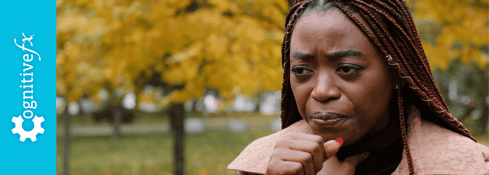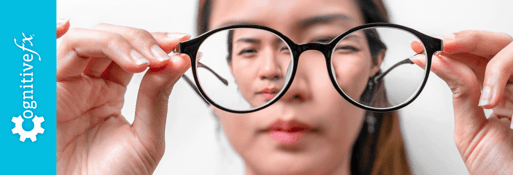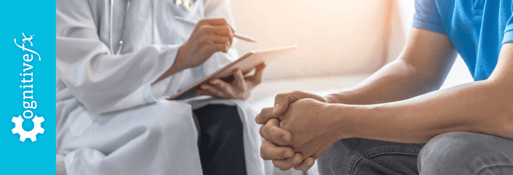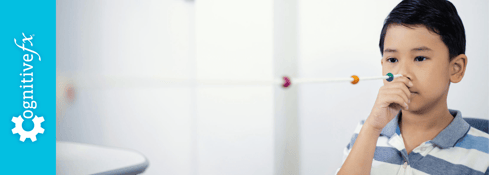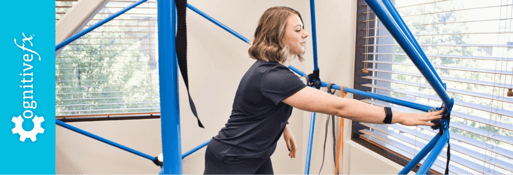When most people think of COVID-19 symptoms, they often recall the most common acute symptoms: brain fog, sore throat, congestion, headaches, and the like. What many don’t know is that long COVID can affect your vision for months after contracting the illness.
Current studies show that 1 in 10 COVID patients experience at least one eye problem, such as dryness, redness, blurred vision, or sensitivity to light. Conjunctivitis is common in the early stages of the illness, and for some patients, it’s the first sign of a COVID-19 infection.
However, as we’ll discuss in this article, the real number of patients experiencing eye issues is likely higher, and the range of symptoms is much broader. Red and watery eyes are easy to spot, but it can be challenging for patients to recognize symptoms that stem from gaze and focus abnormalities. Some examples of potentially vision-related symptoms are headaches, difficulty focusing while reading, feeling overwhelmed in crowded spaces, dizziness while in a moving vehicle, and more. Because most research studies (a) rely on asking patients about their symptoms and (b) don’t include all of the appropriate tests to diagnose vision problems, many post-COVID vision changes go unreported.
We also know that COVID patients don’t just experience vision problems. They also have a wide range of symptoms, from cognitive issues to digestive problems. The best approach to recovery for these patients is one that considers the whole person. It’s key that post-COVID patients find a provider who can address the wide range of effects long COVID has throughout the body and who is willing to diagnose the root issue (rather than treating just symptoms).
At Cognitive FX, we look at how the virus has affected your brain and body, then devise a plan to restore normal function. Our approach involves a combination of aerobic exercise and multidisciplinary therapies to address specific issues that you’re experiencing, including problems with your vision if you have them.
In this article, we’ll look at:
Our treatment was originally designed to help post-concussion patients recover from persistent symptoms. After just one week of treatment, over 90% of our patients show improvement. Thus far, we’ve seen similar results with long COVID patients who pass our current screening criteria. To discuss your specific symptoms of COVID-19 and determine whether you’re eligible for treatment at our clinic, schedule a consultation.
Can COVID-19 Cause Vision Problems?
-1.jpg?width=1000&height=450&name=Vision%20Problems%20After%20COVID%20Causes%20and%20Treatment%20(3)-1.jpg)
Soon after the coronavirus pandemic started in 2020, ophthalmologists worldwide started reporting how patients infected with the virus were experiencing visual symptoms during their illness. Common symptoms identified during these early stages included conjunctivitis, dry and itchy eyes, blurry vision, and sensitivity to light.
However, over the past two years, the medical community and ophthalmology experts spotted a wider range of symptoms than previously expected, such as issues with saccades (how your eye switches focus from point to point), control of eye movements, and communication issues between the vestibular and visual systems. These issues are difficult for patients themselves to recognize and many doctors are not trained to look for and diagnose them. As a result, there are some misconceptions about the impact of COVID-19 on vision.
When you think of problems with vision, you might think of people who need to wear glasses. Some see well at a distance but need glasses to see images that are near (hyperopia), while others can see objects that are near clearly but need glasses to see distant objects (myopia). Someone with 20/20 vision can see both near and far objects clearly and thus does not need glasses.
However, it’s possible to have vision-related changes triggered by COVID-19 and still have 20/20 vision. Many vision problems don’t affect visual acuity. Patients' eyes may not converge or diverge correctly. They might struggle with certain types of eye movement, experience reduced peripheral vision, and not see clearly when they’re moving… the list of possible problems with your eyes is quite long.
This brings us to our first misconception: Many patients believe that just because they haven’t noticed any problems with their vision that their eyes and visual system are functioning normally. In reality, it can be quite difficult to detect problems in your own vision because your brain does its best to compensate.
Instead of noticing your eye problems, you’re more likely to experience the symptoms those eye problems result in: headaches, dizziness, nausea, difficulty concentrating, fatigue, and more. Most people are not aware of how the visual system can cause these symptoms, and they never think to seek help from a vision specialist.
A second misconception is that vision problems caused by COVID-19 are rare. This is somewhat supported by clinical studies. Studies over the past two years found ocular manifestations in patients with COVID-19 ranging from 2% to 32%, with most results hovering around 10%.
However, we believe the real value is much higher. Most of these studies only followed participants for a few weeks and looked for obvious symptoms like red and itchy eyes, which are easy to detect. Symptoms like problems with divergence (the ability to focus on a distant object) and convergence (the ability to focus on a close object) require specialized tests.
In addition, symptoms may not develop immediately and might come and go in waves like many other long COVID symptoms. To get a more accurate understanding of the situation, we need clinical studies which follow patients for more extended periods and which test for a wider range of symptoms.
Vision Symptoms Caused by COVID-19
.jpg?width=1000&height=445&name=Vision%20Problems%20After%20COVID%20Causes%20and%20Treatment%20(8).jpg)
One of the most commonly reported eye conditions caused by COVID-19 in both children and adults is conjunctivitis (colloquially called pink eye). Some studies found that 9 in 10 patients with eye symptoms experience this condition. These patients often experience red and itchy eyes, dry eyes, watery eye discharge, sensitivity to light, and eye pain. In some cases, this eye condition may also cause blurry vision and swollen eyes.
In addition to conjunctivitis, vision symptoms caused by COVID-19 may include the following:
- Ocular irritation
- Red eyes
- Eye soreness
- Blurry vision
- Tunnel vision
- Double vision
- Vision loss
- Floaters in the eyes
- Cotton wool spots
- Loss of peripheral vision
- Uveitis (inflammation of the eye)
- Eye infection
- Swollen eyelids
- Sensitivity to light
- Glaucoma
- Divergent and convergent issues
- Saccades problems
- Gaze fixation issues
- Problems with focus
- Vestibular-ocular deficiencies
- Retinal artery occlusion and retinal vein occlusion caused by hemorrhage or blood clots
Causes of Vision Problems After COVID-19
.jpg?width=1000&height=445&name=Vision%20Problems%20After%20COVID%20Causes%20and%20Treatment%20(7).jpg)
There are many possible ways to explain how COVID-19 can cause vision problems. For most patients, it’s likely a mixture of multiple factors. Some of the most important reasons include…
- Disruption of the Autonomic Nervous System (ANS)
- Neurovascular Coupling (NVC) dysfunction
- Direct impact on brain function related to vision
- Vestibular issues
- Pre-existing visual dysfunction
- Side effects of medication
- Blood clots
- Direct viral attack on the eyes
- Ventilators
Disruption of the Autonomic Nervous System (ANS)
We’ve discussed in a previous post how COVID-19 can disrupt the normal functioning of the autonomic nervous system (ANS).
Along with other important functions like controlling heart rate and blood pressure, this part of the nervous system is also involved in vision. Specifically, it controls the movement of the iris to fine-tune the amount of light that enters the eye, similar to a camera aperture.
The ANS has two important components: the sympathetic nervous system (SNS) and the parasympathetic nervous system (PNS). Stimulation of the sympathetic branch, which triggers "fight or flight" responses when the body is under stress, induces pupil dilation. In contrast, stimulation of the parasympathetic system, known for "rest and digest" functions, causes the pupil to contract.
Under normal circumstances, SNS and PNS work in balance, and the size of the pupils change as needed. In COVID patients, however, the SNS tends to be dominant, which may cause some vision issues, such as light sensitivity and blurry vision.
Neurovascular Coupling (NVC) Dysfunction
Vision problems can also occur if there’s a disruption in the way nerve cells receive the resources they need to function normally. Under normal circumstances, brain cells get nutrients and oxygen from a network of blood vessels. The dynamic relationship between blood vessels and the particular neuronal clusters they supply with resources is called neurovascular coupling (NVC).
If this dynamic relationship is disrupted, affected regions of the brain may struggle to perform regular functions. Researchers have already established that COVID-19 can have a long-term impact on the brain. Recently, a study found damage in multiple brain regions over four months in elderly adults after they experienced a COVID infection. If you want to find out more, we have written about this important study in more detail in another post.
It’s not unreasonable to think that if the virus affects function in the visual cortex — the primary region of the brain that receives and processes visual information — it can lead to vision problems such as poor visual acuity, loss of field of vision, and sensitivity to light.
If you notice that your vision gets worse during or after highly demanding cognitive tasks, you're likely experiencing symptoms caused by NVC dysfunction. It’s also not unusual for the effects of NVC dysfunction to combine with ANS dysfunction.
Vestibular Issues
Many COVID-19 patients also experience symptoms affecting the vestibular system, including dizziness, balance problems, and vertigo. A common complaint for these patients is that their vision is also affected. They can have problems focusing on objects or “seeing” objects moving from side to side. (There are evolving hypotheses linking COVID’s effect on the brainstem to these symptoms.)
This occurs because the vestibular system communicates with the eyes via an automatic function called the vestibulo-ocular reflex (VOR). The VOR is crucial to maintaining both balance and clear vision, controlling the position of the eyes so that when you move, you can keep your gaze stable and fixed on a certain point. However, if this system is not working properly due to a Sars-CoV-2 infection, patients may experience blurry or double vision, even though there’s nothing wrong specifically with the eyes.
.jpg?width=1999&height=1333&name=Vision%20Problems%20After%20COVID%20Causes%20and%20Treatment%20(4).jpg)
Pre-existing Visual Dysfunction
Some patients have vision problems they aren’t aware of which are then exacerbated by COVID-19. The brain does an amazing job of compensating for small problems in eye coordination and other visual issues. But if your brain is affected by COVID-19, it may not have enough bandwidth to compensate for those issues any longer. The result is a seemingly new set of vision problems when in reality, they just weren’t bad enough to cause symptoms until now.
Side-effects of Medication
Some commonly prescribed drugs can have adverse ocular effects. Some of these go away when the patient stops taking the medication, but others may cause irreversible vision loss.
This is particularly dangerous for COVID patients with diabetes, heart disease, and hypertension. For example, some medications for hypertension and diabetes cause abnormalities in pupil size, while some drugs for heart disease increase the risk of cataracts and cause eye irritation. The list of medications with a potential impact on vision includes steroids, antihistamines, antipsychotics, and any meds that affect blood flow. (Some research shows a large increase in the incidence of macular degeneration linked to blood pressure medication).
In addition, some antiviral medications can cause mild eye inflammation and redness, as well as blurry vision and ocular pain. However, there is no evidence that meds routinely used to treat most COVID-19 patients can cause vision problems.
Our advice is to contact your physician or eye doctor if you experience any visual symptoms. Most symptoms are only mild, and you may feel that these problems are a reasonable trade-off for a potentially life-saving drug. Make sure you inform your doctor of all the medications you take, including prescription and over-the-counter, along with the dosages.
Other Possible Causes
Poor blood flow to the retina and cornea: Blurred vision can result from the virus blocking, or at least restricting, the blood supply to the eye. This is known as retinopathy. Without nutrients and oxygen, the tissue in the retina may start to swell and die, making this area look white and fluffy, like cotton wool. These are commonly known as cotton wool spots and do not typically affect a person's visual acuity but may cause eye pain.
Direct viral attack: The virus may be able to get into the body through the eyes. If SARS-CoV-2 reaches the surface of the eye, it can travel through the mucous membrane and eventually reach the retina in the back of the eye. Expression of the ACE-2 receptor allows the virus to infect cells in the eye, which may explain many symptoms such as conjunctivitis, red and itchy eyes, and blurry vision. Given the connection between the eye and brain via the optic nerve, infection of the retina could be a way for the virus to reach the brain and cause further damage.
Ventilators: COVID patients who suffered a severe COVID-19 infection may develop vision problems after being on a ventilator. A study suggested that some patients on ventilators have nodules growing on the macula of the eye (this macular part processes what’s directly in front of the eyes), increasing the risk of conjunctivitis, vascular problems, and potential loss of vision.
Treatment at Cognitive FX
.jpg?width=1999&height=1333&name=Vision%20Problems%20After%20COVID%20Causes%20and%20Treatment%20(2).jpg)
Most long COVID patients who experience vision problems and eye disease also have a wide range of other symptoms, such as brain fog, difficulty sleeping, and headaches, to name just a few. Instead of looking at visual issues in isolation, our approach is to tackle the root of the problem and address multiple symptoms at the same time.
Before treatment, you will undergo a detailed medical examination, allowing our doctors to find out more about your medical history and current symptoms. Part of our evaluation includes a functional Neurocognitive Imaging scan (fNCI) to identify which regions of the brain were affected by neurovascular coupling dysfunction and how well they’re communicating with other brain regions. The scan includes 56 areas of the brain. Using the information from the scan and the medical examination, our team will design a treatment plan custom-made for your needs.
For example, this part of an fNCI report shows regions involved in reading comprehension, whether they are hypoactive (indicated a blue color on the report), and whether they’re communicating with each other as expected:
-1.jpg?width=552&height=305&name=Vision%20Problems%20After%20COVID%20Causes%20and%20Treatment%20(2)-1.jpg)
During our treatment — called Enhanced Performance in Cognition, or EPIC for short— patients receive multidisciplinary therapy, including…
- Vision therapy
- Neuromuscular therapy
- Occupational therapy
- Vestibular therapy
- Cognitive therapy
- Sensorimotor therapy
- Neurointegration therapy
- Psychotherapy
- And more.
These therapies are appropriate therapeutic approaches for NVC dysfunction, autonomic dysfunction, vision problems, and vestibular issues. Some of the post-COVID symptoms these therapies can help resolve in addition to vision include…
All of our therapies have a visual component and will address some of your symptoms. However, we also have specific activities to rehabilitate your vision, such as the Brock string and Dynavision.
.jpg?width=1999&height=1333&name=Vision%20Problems%20After%20COVID%20Causes%20and%20Treatment%20(6).jpg)
Our therapists use the Brock string for patients who are experiencing visual perception issues. This tool helps retrain the eyes to work together to focus on beads located at different distances along the string.
Dynavision is a computerized light board where patients push buttons as they light up, following different patterns on the board. The task may be as simple as hitting every button that lights up as quickly as possible, or it may be more challenging, where you only hit the green and avoid the red lights. This is a great tool to improve oculomotor coordination and for activating several brain regions involved in movement, cognition, and vision.
.jpg?width=1999&height=1333&name=Vision%20Problems%20After%20COVID%20Causes%20and%20Treatment%20(5).jpg)
Many of our patients experience significant improvements in just one week in many of their symptoms, but vision problems often need more than one week’s worth of therapy. It may take from six months to a year of vision therapy for your eyes to fully recover. We can refer you to a vision specialist in your hometown and show you how to do specific exercises at home.
Our patients report a significant decrease in symptoms related to emotional function, sleep, concentration, clarity of thought, memory, and light sensitivity at the end of one week of treatment.
While many other symptoms show direct improvement, they often require some rest at home or continuing therapy for a more marked improvement. Many patients are understandably tired after an intense treatment protocol and experience less fatigue when they’re able to rest at home.
-2.jpg?width=552&height=840&name=Vision%20Problems%20After%20COVID%20Causes%20and%20Treatment%20(3)-2.jpg) Percent symptom decrease based on 43 patient evaluations.
Percent symptom decrease based on 43 patient evaluations.
At the end of treatment, you will receive a second fNCI scan to see how your brain is improving. Then, our clinicians will analyze your results and give you some homework, which typically includes aerobic exercise, cognitive games, and cognitive rest to help you continue your recovery journey at home.
Tips to Help You Cope With Vision Symptoms at Home
Not surprisingly, COVID long haulers with visual symptoms can experience difficulties with many daily activities, including cooking, shopping, watching television, and reading. Here are a few tips to improve eye health and cope with your symptoms at home and work:
- Follow the 20-20-20 rule: If your work involves long periods of the day in front of a computer or any other activities that rely heavily on your vision, you might suffer from mental fatigue, dry eyes, and headaches. Throughout the day, take a 20-second break away from the computer every 20 minutes and focus on an object about 20 feet away from you. This is a quick and easy exercise to reduce eye strain. Also, limit screen time as much as possible.
- Palming to relax your eyes: Cup your hands and apply gentle pressure over the sockets of your eyes for about 30 seconds. Close your eyes and breathe deeply. You can repeat this exercise throughout the day to relax your eyes. For your eye care routine, you may also find it helpful to apply eye drops (but avoid overuse).
- Make a conscious effort to blink more during the day. This lubricates your eyes and helps your brain to process new visual data more efficiently.
- Be strategic with lights. Make sure lighting in your home is sufficiently bright to see, but not so bright that it increases headaches. Use blue filters on electronic devices such as phones and tablets. You can also purchase screens specifically designed to reduce eye strain, but these can be expensive.
- Reduce tripping hazards. Always keep your home tidy and avoid clutter. If possible, move small furniture items, such as side tables, to open up clear pathways to walk.
- Use contrasting colors. Contrasting colors can help you find items more easily. For example, replace doorknobs and light switches with colors contrasting with the wall, and use a light cutting board to chop dark-colored food items.
- Use audio devices. Many smart home devices now have talking features, which can be helpful if you have significant visual reduction. This includes, for example, setting alarms and reminders, locking and unlocking doors, and reading audiobooks.
- Learn breathing exercises. Intentionally controlling your breath is a powerful tool to soothe your nervous system, which in turn helps with your vision. When you exhale for longer than you inhale, the vagus nerve — which runs from the neck down to the diaphragm— sends a message to your brain to switch on your parasympathetic nervous system and deprioritize your sympathetic nervous system.
- Get a second opinion. If you’ve only visited an optometrist and were told your eyes were fine, but you’re still experiencing post-COVID vision-related symptoms, consider contacting a functional optometrist or neuro-ophthalmologist who specializes in functional vision evaluation and therapy.
Recover From Long COVID at Cognitive FX
.jpg?width=1999&height=1333&name=Vision%20Problems%20After%20COVID%20Causes%20and%20Treatment%20(1).jpg)
There aren’t many good healthcare options for those suffering from long COVID, but at Cognitive FX, we’ve seen an average of 60% symptom improvement after just one treatment week. Many of our patients experience improvement by the second day! We can provide more types of therapy at one time than other treatment providers. Your symptoms are real, they have a cause, and they can get better with appropriate treatment.
To determine if you are eligible for our treatment program, please schedule a consultation.

.png)
-1.jpg?width=1000&height=450&name=Vision%20Problems%20After%20COVID%20Causes%20and%20Treatment%20(3)-1.jpg)
.jpg?width=1000&height=445&name=Vision%20Problems%20After%20COVID%20Causes%20and%20Treatment%20(8).jpg)
.jpg?width=1000&height=445&name=Vision%20Problems%20After%20COVID%20Causes%20and%20Treatment%20(7).jpg)
.jpg?width=1999&height=1333&name=Vision%20Problems%20After%20COVID%20Causes%20and%20Treatment%20(4).jpg)
.jpg?width=1999&height=1333&name=Vision%20Problems%20After%20COVID%20Causes%20and%20Treatment%20(2).jpg)
-1.jpg?width=552&height=305&name=Vision%20Problems%20After%20COVID%20Causes%20and%20Treatment%20(2)-1.jpg)
.jpg?width=1999&height=1333&name=Vision%20Problems%20After%20COVID%20Causes%20and%20Treatment%20(6).jpg)
.jpg?width=1999&height=1333&name=Vision%20Problems%20After%20COVID%20Causes%20and%20Treatment%20(5).jpg)
-2.jpg?width=552&height=840&name=Vision%20Problems%20After%20COVID%20Causes%20and%20Treatment%20(3)-2.jpg)
.jpg?width=1999&height=1333&name=Vision%20Problems%20After%20COVID%20Causes%20and%20Treatment%20(1).jpg)

